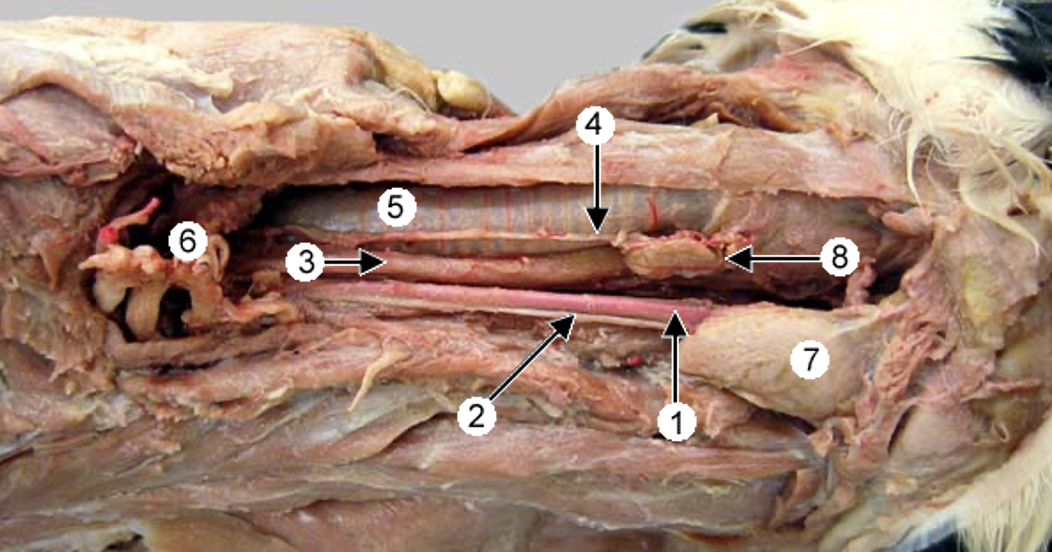Esophagus
1/13
There's no tags or description
Looks like no tags are added yet.
Name | Mastery | Learn | Test | Matching | Spaced |
|---|
No study sessions yet.
14 Terms
Relationship with pharynx
Continues from larynogopharynx
3 parts of esophagus
Cervical part
Thoracici part
Abdominal part
Cervical part of esophagus
Location
Location in relation of trachea
Location: Between longus colli and trachea
Location in relation of trachea: Left side of trachea at thoracic inlet
Thoracic part of esophagus
Location
Location in relation of trachea
Passes via
Location in relation to lungs and aorta
Location: From thoracic inlet to diaphragm
Location in relation of trachea: Returns dorsal to the trachea on dorsal mediastinum
Passes via: Dorsal trachea bifurcation, right side of artic arch and through esophageal hiatus
Location in relation to lungs and aorta: Between lungs and ventral to aorta
Abdominal part of esophagus
Short

Cervical Part of Esophgaus
Label 1-7
Common carotid artery
Vagosympathetic trunk
Esophagus
Trachea
Brachial plexus
Medial retropharyngeal lymph node
Thyroid gland
In which view, left lateral or right lateral can you clearly see the esophagus?
Right lateral view
What is the esophagus?
A muscular tube
What are the 3 layers of the esophagus wall?
T. adventitia
T. muscularis
T. mucosa
T. Advantitia
What kind of connective tissue
Connective tissue: Loose connective tissue that connecting adjacent structures to allow movement
T. Muscularis
What kind of contraction
Structure in
Dog & ruminent
Pig
Cat & horse
What kind of contraction: Wavelike contraction to move bolus toward stomach
Structure in:
Dog & ruminant: Entirely striated muscle
Pig: Has short part of smooth muscle near cardia
Cat & horse:
Cranial 2/3 striated muscle
Caudal 1/3 smooth muscle
T.mucosa
Structure
What is the epithelium like in T. mucosa?
Structure like in
Dogs
Pig
Horse, ruminant and cat
Structure: Contains epithelium, lamina propria and lamina muscularis (submucosa)
Epithelium: Stratified squamous epithelium
Structure like in:
Dogs: Submucosa that contains mucus glands over entire length of esophagus
Pig: Glands only present in cranial half of esophagus
Horse, ruminant and cat: Glands only present at pharynoesophageal junction
Why can’t horses vomit?
Because they have strong esophageal sphincter that allows one-way entry only
Blood Supply and Innervation
Cervical part
Artery
Vein
Thoracic part
Artery
Vein
Innervation by
Artery and vein in:
Cervical part:
Artery: Branch of common carotid artery
Vein: External jugular vein
Thoracic part:
Artery: Bronchoesophageal artery (from thoracic aorta)
Vein: Bronchoesophageal vein (empty into azygous vein)
Innervation by: Vagus (parasympathetic) and thoracolumbar (sympathetic)